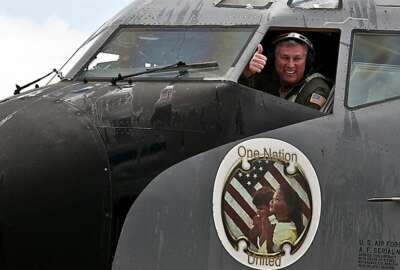
Air Force’s experimental way of training pilots finishes first iteration, but it may be a while before it sees results
The Air Force finished its first 15-month Pilot Training Next program.
Imagine a collective mind of all the pilots in history guiding you through your flight training in the Air Force.
The idea isn’t as far-fetched as it may sound. The Air Force is finishing up its first 15-month long Pilot Training Next program in Austin.
The goal of the program is to give pilots their own flight simulators to practice in whenever they want. As the pilots practice, the simulator takes their biometric measures — where their eyes go, what their heart rate is and much more.
The Air Force plans to aggregate that data and use it to help pilots train in the future. Using biometrics to see what flight aspects stress them the most and figuring out how to get a pilot through that hurdle.
The pilots also get much more practice in state-of-the-art simulators that help prepare them for real-life flight.
And the Air Force says it’s working.
“It’s actually amazing what I’ve seen,” said Capt. John Joern, Pilot Training Next instructor, in an interview with Federal News Radio. “A traditional ride in a T-6 for a student in a traditional pilot training base looks like the instructor flying about 95 percent of it, the student maybe flying about 5 percent of it when they are not making gross mistakes. Here, when I took a student up for their very first ride, they’re doing competencies well into the middle of [a traditional] program and they’re flying about 90 percent of the sortie, while I’m just trying to demo the 10 percent.”
This iteration of the program trained 15 officers and five enlisted airmen.
2nd Lt. Christopher Ahn, one of the pilots in training, said the ability to train whenever he wanted helped him learn better.
“It’s got seats like a normal arcade racing game, but instead of a steering wheel you have a stick to control the plane and instead of the gears you have the throttle and also on your feet you have the rudders. In front of you is a computer screen, it’s a normal Windows computer using virtual reality flight simulators that anyone can buy, and we also have virtual reality headsets that we put on our eyes,” Ahn said. “The great thing about this program is I can do it any time I want. Can’t sleep at night? I’m just going to hop in the simulator at one a.m. … We have it at home and we have it at work as well. The one at home I have in my living room.”
Giving the pilots the ability to train anywhere takes away many of the limiting factors keeping pilots in traditional programs from training.
But as the pilots are learning, so is the Air Force, using the pilots’ biometric activity.
“What we are hoping to do is have those biometrics up on the screen for us. I can see the students’ heart rate, breathing rate and maybe have a heat map of what their eyes are looking at to see if they are fixating on one thing they shouldn’t be or are they having a good crosscheck of everything. We also hope to vary the challenge. So, if a student is not having a challenge to maximize their learning, we can give them more challenge weather, we can give them traffic conflicts, we can maybe give their aircraft an emergency to expand that learning,” Joern said.
He added the biometrics will help the Air Force figure out what the trainees’ biggest stressors are and what they are less confident in.
Of course, this is all in the future and the Air Force is still figuring out the best ways to use the data it is collecting.
“That’s one of the more challenging things,” said Scott Van de Water, deputy director of Pilot Training Next at Air Education and Training Command. “Where we see this going in the medium term is having a little bit more data analytic capacity. But in order to do data analytics you need to have robust data sets and you need to be able to dissect those data sets and make sense of them in a meaningful way. We need to spend a lot of time looking at how to understand the data we are gathering in order to make sure the conclusions we are drawing are valid and in order to make those decisions based on solid ground.”
The Air Force says it will take time to learn more about trainees and how they best learn.
The service will start its second iteration of the program in January.
Copyright © 2024 Federal News Network. All rights reserved. This website is not intended for users located within the European Economic Area.
Scott Maucione is a defense reporter for Federal News Network and reports on human capital, workforce and the Defense Department at-large.
Follow @smaucioneWFED
Related Stories





